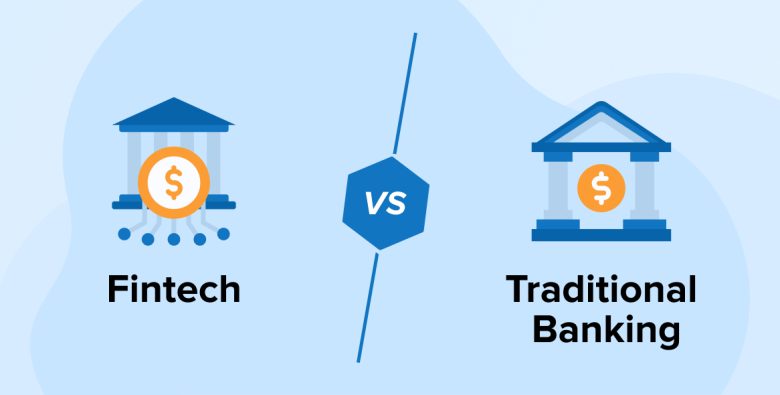The rise of financial technology (FinTech) has transformed the financial system, especially for traditional banks. FinTech refers to the application of new technology to financial services to make them more efficient, user-friendly, and affordable. Recently, FinTech has significantly changed the way individuals and businesses interact with money. FinTech has not only changed the traditional banking model in many ways, but it has also made financial transactions easier for users. It has also changed the way banks operate and are structured. Changing customer expectations, new technologies, and increasing competition in the financial sector are driving this change.
Digital Banking is Becoming the Norm
Digital banking is one of the most notable ways in which FinTech has changed traditional banking. Previously, customers had to go to a physical bank branch to perform simple tasks such as opening an account, depositing a check, or applying for a loan. FinTech has made almost all of these services accessible online or through mobile apps. Banks are investing heavily in digital systems that allow customers to manage their accounts, transfer money, and get help without having to go to a branch. This move to digital banking is more than just a trend; it’s a significant shift to meet the expectations of a tech-savvy generation that values speed, convenience, and anytime, anywhere access.
Automated and Efficient Banking
Fintech has automated many aspects of banking, simplifying transactions that previously required manual input and action. The application of artificial intelligence and machine learning has significantly improved operational efficiency, from automatically approving loans to detecting fraud instantly. Algorithms allow traditional banks to process vast amounts of data in real time, speeding up decisions and reducing errors. For example, chatbots can answer customer queries 24/7, reducing the need for customer service agents. This automation not only saves banks money but also improves the customer experience by responding to customer needs more quickly and accurately.
Challenger Banks and Intensified Competition
Purely digital banks (often referred to as challenger banks or neobanks) have intensified competition in the financial sector. These banks operate exclusively online and do not have physical branches. They generally offer simpler services and lower prices. Because they are flexible and use technology, they can quickly launch new programs such as instant account opening, real-time spending reminders, and free cross-border transactions. To remain competitive, traditional banks have had to rethink their plans, invest in new technologies, and improve their digital services. More competition is good for customers because it offers them more choice, better services, and lower prices.
Enhanced Security and Fraud Prevention Measures
Security has always been a major concern in the banking industry, and fintech offers banks new ways to improve safety and security. Biometric authentication technologies such as fingerprint scanning and facial recognition are used by traditional banks. These methods are more secure than regular passwords. Artificial intelligence (AI) is also crucial in detecting fraud. AI systems can quickly identify suspicious activity by looking at transaction patterns and consumer behavior in real time. Such detection helps stop fraud before it can cause damage. These additional security measures make people more likely to trust and use digital banking platforms, which is crucial for their widespread adoption.
Expanding Financial Inclusion
Fintech has made financial services more accessible to more people, a major change for traditional banks. Millions of people worldwide are unbanked or have insufficient funds because they cannot go to a physical bank or use standard credit assessment procedures. Digital wallets and mobile banking apps are two examples of fintech innovations that are helping to bridge this gap. Banks are using these technologies to reach remote areas and communities that do not have access to basic financial services. They offer services via mobile phones and the internet. Digital identity verification and other credit assessment methods have also made it possible for people with little or no credit history to use banking services and obtain credit.
Better Lending and Credit Services
Fintech has also changed the way traditional banks lend money. In the past, it could take a long time to get a loan because you had to fill out a lot of paperwork and go through a credit check. Thanks to fintech tools, banks can now assess a loan application in minutes using automated underwriting systems. These algorithms look at a wider range of data points, such as income trends, social media activity, and digital transaction history, to determine an individual’s credit profile. This approach makes it easier and faster for people to borrow money and reduces the risk for banks. Banks have also changed the way they lend money with the rise of peer-to-peer lending platforms, offering better interest rates and faster payouts.
How the Role of Bank Branches Is Changing
As digital banking becomes more popular, the role of traditional bank branches is also changing. Many banks are closing branches they don’t use frequently and exploring new ways to utilize physical locations. Banks are no longer just places to do everyday business; they have become advisory centers where customers can get professional financial advice and assistance with more complex needs. To combine the digital and physical experience, some banks have even added digital kiosks and self-service options in their branches. Fintech has had a direct impact on this change, shifting banks to focus on delivering valuable services while technology performs their daily tasks.
Conclusion
Fintech is changing the way banks operate, driving innovation, improving efficiency, and increasing customer satisfaction. Fintech has changed the way banks serve customers and run their businesses by enabling digital banking, personalized services, automation, and better security. Traditional banks still play an important role with their brands and resources, but the need for change is more urgent than ever. Banks that want to remain competitive in the digital age must now leverage fintech. As the financial world changes, the future of banking will be shaped by the collaboration between traditional banks and fintech startups.
FAQs
1. What is FinTech in simple terms?
FinTech, short for “financial technology,” refers to the use of technology to deliver financial services in new and innovative ways.
2. How is FinTech different from traditional banking?
FinTech uses digital tools and automation to provide faster, more personalized, and often cheaper financial services than traditional banking processes.
3. Is FinTech replacing traditional banks?
Not really. Many traditional banks are using FinTech to improve the quality of their services, stay competitive, and avoid being replaced.
4. What are the applications of FinTech in the banking sector?
For example, mobile banking apps, online loan applications, robo-advisors, digital wallets, and blockchain-based transactions.
5. Why is FinTech important for the future of banking?
FinTech makes banks more efficient, more customer-focused, and more flexible in responding to changing market needs. This enables banks to remain competitive in an era where digitalization is preferred.




